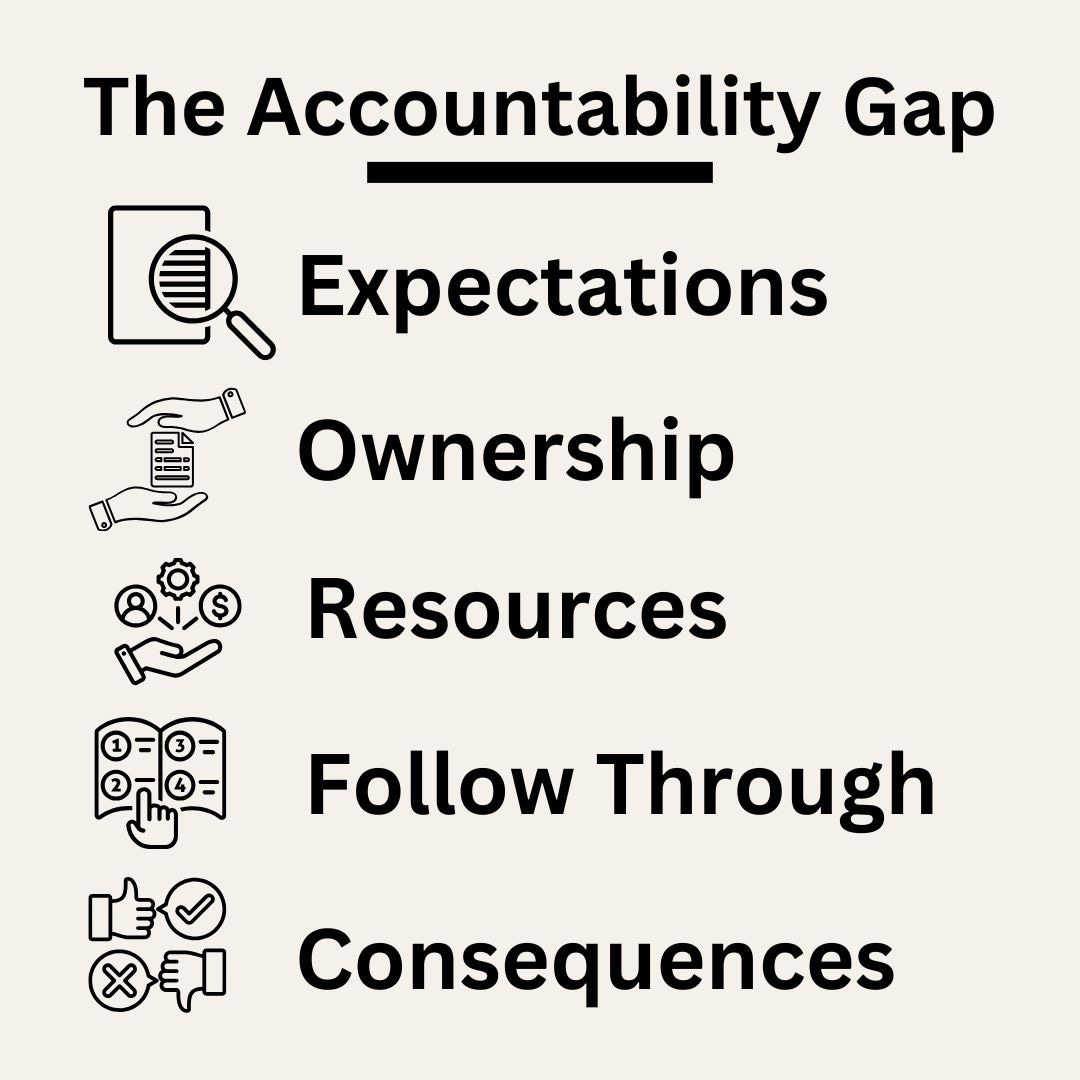The Accountability Gap Part 4
There are 5 core components of accountability. Can these help close the gap?
We’ve all seen it before—a bold initiative, a strategic plan, or even just a small team goal that starts with energy and enthusiasm but fizzles out before reaching the finish line. What happened? The Accountability Gap happened. This gap exists when there’s a disconnect between expectations and execution, causing commitments to fall through due to unclear communication, lack of follow-through, or systemic barriers. It’s not about laziness or bad intentions; it’s about structural breakdowns in how we set, support, and sustain accountability.
This isn’t just a workplace issue. The Accountability Gap is everywhere—from unfinished New Year’s resolutions to school improvement plans that never take root.
Need to explore the causes? Check out Part 2.
Core Components of Accountability
To truly close the gap, we need to break accountability into five essential elements.
Expectations (What needs to happen?)
Expectations are the foundation of accountability. Without clear expectations, people operate on assumptions, leading to misalignment and confusion. Key aspects include:
Clearly defining roles, responsibilities, and deliverables.
Ensuring alignment between tasks, goals, and organizational priorities.
Creating a shared understanding of success so that everyone knows what “done right” looks like.
🔍 Common Pitfall: Vague expectations, such as “Do your best” or “Improve communication,” leave too much room for interpretation. Clear, measurable expectations are essential.
Ownership (Who is responsible?)
When everyone is responsible, no one is accountable. Ownership means clearly identifying who is responsible for what, ensuring that commitments don’t get lost in group settings. Key strategies include:
Assigning clear responsibility to individuals or teams.
Avoiding the diffusion of responsibility where tasks are passed around without resolution.
Strengthening personal accountability so people own their commitments.
🔍 Common Pitfall: Leaders assume that simply assigning a task means someone will take full ownership. Without a sense of personal investment, things fall through the cracks.
Resources (How will it happen?)
Even the most motivated people can’t succeed without the right support. This includes:
Providing the necessary time, tools, training, or authority to execute tasks effectively.
Identifying and addressing obstacles or bottlenecks that might prevent follow-through.
Ensuring alignment between expectations and capacity—because unrealistic goals set people up for failure.
🔍 Common Pitfall: Leaders sometimes mistake motivation for capability. Even highly committed people need the right conditions to execute well.
Follow-Through (What keeps it on track?)
Setting goals is easy—sticking to them is the challenge. Follow-through ensures that accountability remains a priority, not just an initial promise.
Establishing systems for tracking progress (check-ins, milestones, and feedback loops).
Having consistent alignment meetings to address issues before they escalate.
Addressing missed steps without delay so small lapses don’t turn into big failures.
🔍 Common Pitfall: Many schools and organizations set goals but fail to track progress. Without regular follow-ups, accountability fades away.
Consequences (Why does it matter?)
People follow through when there’s a reason to do so. Consequences—both positive and negative—help reinforce accountability.
Establishing clear stakes for success or failure so responsibilities feel meaningful.
Celebrating small wins to build momentum and motivation.
Addressing accountability gaps constructively, without blame, but with a commitment to learning and improvement.
🔍 Common Pitfall: Leaders sometimes avoid tough conversations about missed commitments, leading to a culture where accountability is optional.
Why This Matters
Accountability gaps aren’t just an organizational inconvenience—they erode trust, slow down progress, and create frustration for everyone involved. Whether you’re leading a school, an organization, or just trying to stick to personal goals, mastering accountability is the key to turning intentions into impact.
When expectations are clear, ownership is strong, resources are available, follow-through is prioritized, and consequences are meaningful, accountability isn’t just an abstract concept—it’s a culture.
The next time you see a great idea falter, ask yourself: Where is the gap? That’s the first step to closing it.
That’s it on the Accountability Gap for a bit! I have WAY more on accountability but I have other things I want to share with you all.






Good, clear, and right on target.
I wrote about this (perhaps less succinctly) recently here: https://brokenhand.substack.com/p/the-fickle-feather-of-maat